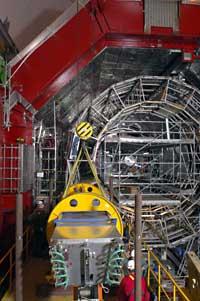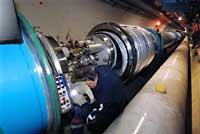Giant to explore the small

In particle accelerators, scientists do what their name indicates: speed up particles, accelerate and crash. They work with particles smaller than the atom to better know the principles of physics and the universe.
To do what is said in a nutshell, they need the latest technology. They need cutting-edge technology for conducting experiments (the accelerator is located in a 27-kilometer circular tunnel, extremely efficient superconductor magnets are needed to speed up and control protons, they will work almost at zero absolute, vacuum...), and need a cutting-edge computing capability to receive, analyze and interpret the results (if taken into account that they calculate that they will accumulate annual information for 15 petabytes, enough information available for 2,250,000 DVD. The LHC is a giant project that has required a huge investment. The tour has had many setbacks and it has been three decades since they commented on it for the first time, but it will finally be launched soon.
The Geneva LHC accelerator will mainly work with protons. They will accelerate spectacularly and make them collide with incredible energy. And scientists will investigate the results of these collisions, that is, they will investigate what particles occur in them, observe what phenomena occur, to better know the principles of the universe, or what is the same, the basic laws of physics.
Physicists use the Standard Model of particle physics to drive in a basic world. Aside from gravity, this model describes all physical forces. It is a theory that gathers almost everything known about particles and subatomic forces and that describes all of them and their relationships through collections of concrete principles and equations. Established in the 1970s, it is the best tool to describe the universe to date. And it is that the advances made since then have always confirmed. However, this model has not adopted them
i am here and I
-joining all the ends and throwing away them, arise other theories. In this zone of strands will work the new accelerator of the laboratory CERN. In fact, physicists have calculated that particles that so far have not been able to be detected or generated can be generated and detected at the energy level in which the accelerator will work.
One of them, the most desired, is the Higgs boson. According to the standard model, the Higgs boson is a basic particle responsible for the particles having mass. The Higgs boson is at the core of the standard model and has to exist to be met. The truth is that they have never detected it, although they announced it in the 1960s. But it seems that the time has come and the participants in the project believe that with the capacity of the LHC they will detect it within a maximum of two years.
When they achieve it, it will be a very important contribution, since it will ratify the model used to understand the universe. However, physicists look forward to the discoveries almost beyond the standard model. It is difficult to understand precisely what they can be: they speak of matter and anti-mating; of supersymmetry, of the model that can happen to the standard model; of new dimensions, of tiny black holes, of new unknown particles, and of the dark matter...
However, although it is not understood exactly, the main idea is the new physics, they expect and want surprises. Physicists working in particle physics are convinced that LHC will be the gateway to a new world and are eager to launch the accelerator. Proof of this is the literature you have created before you start working: The LHC accelerator is significantly mentioned in 4,000 research articles (for the first time in 1984), which has been previous to the CERN has generated slightly less in its 14 years of activity.
Published in Berria
Buletina
Bidali zure helbide elektronikoa eta jaso asteroko buletina zure sarrera-ontzian











